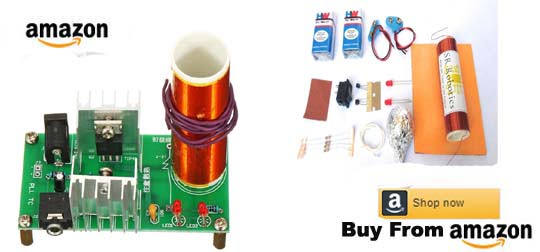What Is Tesla Coil ?
The Tesla Coil we’ve got here is on the smaller side, producing a few hundred thousand volts of electricity. It’s pretty neat because it can actually light up a fluorescent bulb that you hold in your hand!
Now, let’s dive into how the Tesla coil circuit works. When you bring a fluorescent light bulb near the Tesla coil, it lights up and sparks, even without being plugged into anything!
Here’s a bit of quick physics for you: the Tesla coil creates an electric field that kind of pushes electrons through the light bulb. It’s like how the lights in your housework, except in your house, the electricity comes through wires, not through the air.
Now, onto the nitty-gritty details. A Tesla coil is a gadget that can generate really high voltages. Voltage is just a way of measuring how much energy an electric charge carries. These coils can make voltages even over a million volts! The little one we’re using in this demo makes about 60,000 volts. Usually, dealing with such high voltages can be dangerous, but the Tesla coil works with very high-frequency electricity. This means it turns on and off super quickly, so the electricity flows on the outside of your skin instead of through your body.
Now, here’s something cool: The Tesla coil is quite different from the Van de Graaff generator. The generator makes static electricity, where the charges don’t move on their own. But a Tesla coil creates current electricity, where the charges actually flow. One end of the Tesla coil is connected to the ground. Since the coil produces such high voltages, the electricity can leave the coil and travel through the air to get back to the ground. If you hold a fluorescent light bulb near the coil, the electricity will pass through the bulb to get to the ground, and that’s what makes it light up. If you get the bulb close enough to the Tesla coil, you can actually see the electricity jumping into the light bulb. It’s like a mini lightning show! In this article, I will explain How to make a Tesla coil project with a very simple Tesla coil circuit diagram.
How To Make A Tesla Coil Project at Home
Hey everyone who loves tinkering with science stuff! Have you ever wondered about making your own mini Tesla Coil Circuit? It’s this super cool project you can do at home using just basic things you might have lying around. I’m going to guide you through the steps—it’s going to be a blast!
Let’s chat about Nikola Tesla for a second. He’s like that super smart inventor you’d see in movies. But he was real! He teamed up with George Westinghouse to build the first hydroelectric plant at Niagara Falls. That’s a big deal, right? Tesla also came up with some mind-blowing gadgets, like the magnifying transmitter and that famous Tesla coil. His ideas are all over the place, shaping the world around us. And get this, he got nearly 700 patents during his lifetime! That’s a whole lot of brainpower.
Tesla Coil Circuit Diagram

Simple Tesla Coil Circuit Diagram

Parts List For Tesla Coil Circuit Diagram
- Transistor TIP 41 1pc
- Capacitor 1uf or 2.2uf 100 to 400 volt non-polar
- Resistor 10k ohm 1/4watt or 1/2watt
- Pvc Pipe Diameter 2cm length 20cm and also you can experiment with another PVC pipe
Tesla Coil Circuit Diagram Explanation
Hello! Today I’m going to show you how I build a Tesla coil! You may know this device from computer games, movies or some “music tesla show” whatever they call it. If we ignore the mystique around the Tesla coils, it’s just a high-voltage resonance transformer working without a core.
Circuit of the coil, as you can see it’s very simple and we need only a few components. Also, we need a frame for the secondary coil, it could be any dielectric cylinder diameter of approximately 2cm and length of 20cm.
Let’s begin with the most complicated part – the secondary coil. It has 200-1500 turns turn to turn, I am about more than 500 turns. Fix the beginning of the wire and wind you don’t need to count every turn, simply multiply the diameter of the wire by the number of turns you planning to make – it’s going to be your winding length. When you did fix the wire with some tape or better by a couple of layers of varnish.
The primary coil is much easier only 3 to 10 turns of regular wire in PVC insolation. Next is soldering, all under the circuit, PCB is not necessary. Connect primary and secondary coils, and give 12-volt DC as Input. So we have done. Before you turn on the power the first time, put CFL near the coil, because usually you’ll not see high voltage sparks immediately and the only thing notice that it’s working is the light bulb.
It’s quite a weak coil, and you can not get electrical shock because of the effect, but anyway be careful and don’t place any electronic devices such as cellphones, computers etc. near the working coil and notice that high voltage sparks are made of plasma and it’s very hot, be careful when touching it. If the Tesla coil doesn’t work, try to flip wires from the primary coil, usually, it helps, also you can try to add or subtract a couple of turns from it.
Now let’s talk about improving results, first, you can raise voltage, but I don’t recommend going over 24V at this circuit. The second is playing with the primary coil, The logic is simple, fewer turns – more current equals more power and more hitting, I stopped at 3 turns. Please see the full video for the Tesla coil project circuit diagram

